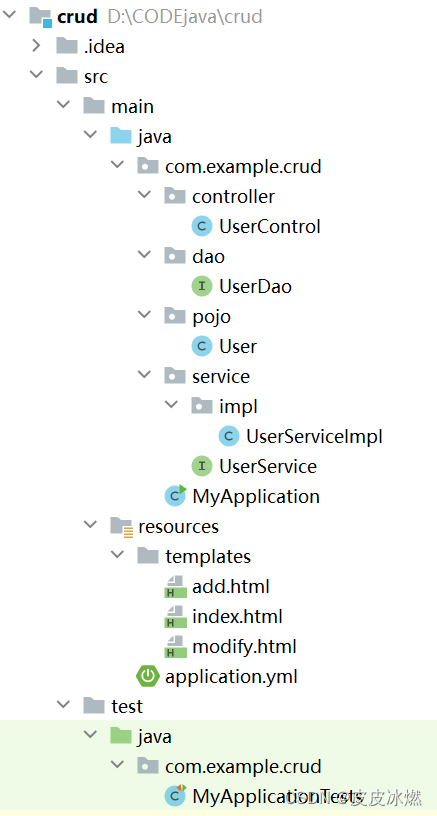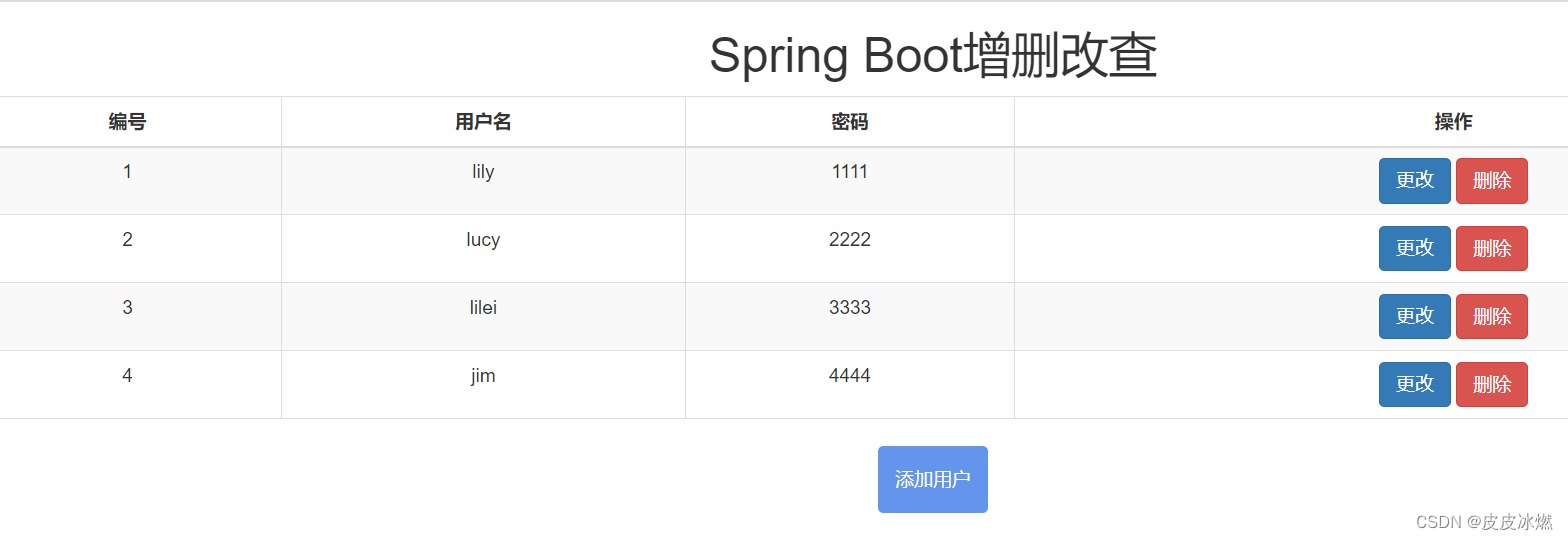Spring Boot简易增删改查(CRUD)案例
Error creating bean with name ‘dataSource‘ defined in class path resource解决办法
SpringBoot启动项目报错 Consider defining a bean of type ‘xxx‘ in your configuration
1 Java各个层级的关系
Domain层(POJO、Enity)
DAO层(也称为mapper层)
Service层
Controller层
1.1 Domain层(POJO、Enity)
Domain层,通常就是用于放置这个系统中,与数据库中的表对应起来的Java Bean的。
一、Java Bean是一种代码规范,当某一个类同时满足下面的三个条件时,那么此类就满足Java Bean规范。
1.书写类时类中的属性全部使用private修饰
2.类中必须有一个无参构造方法。
3.为每个属性提供get/set方法。
二、POJO(Plain Ordinary Java Object):普通的Java对象,其实就是简单的Java Bean实体类,对应数据库里的某一张表,POJO里的每一个属性都和该表中的字段一 一对应。POJO最明显的特点,大致如下:
1.书写类时类中的属性全部使用private修饰;
2.类中必须有一个无参构造方法;
3.然后针对每个参数都定义了get和set方法作为访问的接口;
4.类中除了构造方法、get/set方法外不能够有其他的方法。
三、VO(value object):值对象,又称表现层对象,对应展示界面的数据对象。比如一个前台展示的数据列表,这个列表中的姓名和用户名分别是存在于两个表中的数据,此时数据显示时查询语句用到了多表查询sql,查询出来的数据包含了两个表的字段,此时使用一个Java Bean实体类无法存储返回结果中两个表的数据字段,因此将这两个表中使用到的字段或属性重新封装为一个新的Java Bean,这个Java Bean就叫做VO。通俗来说,vo就是一个自定义的、多个表的属性或字段的集合。
四、Entity层,顾名思义就是实体层,放置一个个实体,及其相应的set、get方法。如果想要对数据库进行一些操作(比如说读取)的话,就要先写entity层。
怎么写entity层?
1.理解业务需求,分析需要从数据库中读取哪些字段;
2.根据这些字段写对应属性,写完后[自动生成get、set方法]。
1.2 DAO层(也称为mapper层)
DAO(Data Access Object)就是写一个类,把访问数据库的代码封装起来,DAO在数据库与业务逻辑(Service)之间。Dao是数据访问层,Dao的作用是封装对数据库的访问:增删改查,不涉及业务逻辑,只是达到按某个条件获得指定数据的要求。
持久层,通常放置执行sql语句的接口类,和数据库打交道,负责执行特定的业务逻辑,例如数据库操作、数据转换等。
对数据库的操作都在DAO中完成 ,如数据库的增删改查。
1.3 Service层
业务层,通常是调用数据层的接口,组织业务逻辑功能,例如数据库操作、数据转换等,根据业务需求对数据层发起调用。通常也是要实现一个接口类方便调用。
Service层会调用DAO层和Domain层,Service层也会对数据进行一定的处理,比如条件判断和数据筛选等等。
为什么service层要使用接口来定义有以下几点好处:
在java中接口是多继承的,而类是单继承的,如果你需要一个类实现多个service,你用接口可以实现,用类定义service就没那么灵活。
要提供不同的数据库的服务时,我们只需要面对接口用不同的类实现即可,而不用重复地定义类。
1.4 Controller层
表现层,通常是要调用Service层中的接口,实现接口的方法。控制器负责接收请求并将其转发给对应的视图或服务进行处理。它通常负责处理请求的路由和参数验证。
Controller层会调用前面三层,Controller层一般会和前台的js文件进行数据的交互, Controller层是前台数据的接收器,后台处理好的数据也是通过Controller层传递到前台显示的。
2 增删改查案例
2.1 基础配置
2.1.1 项目架构
Spring Boot。
前端采用html + thymeleaf模板代替jsp。
.
├── src
│ ├── main
│ │ ├── java
│ │ │ └── com.example
│ │ │ └── crud --业务功能模块 即 CRUD
│ │ │ ├── controller --Controller层
│ │ │ │ └── UserControl
│ │ │ ├── dao --Dao层
│ │ │ │ └── UserDao --Dao层接口
│ │ │ ├── pojo --数据模型
│ │ │ │ └── User --请求体
│ │ │ ├── service --Service层
│ │ │ │ ├── impl --Service层接口的实现
│ │ │ │ │ └── UserServiceImpl
│ │ │ │ └── UserService --Service层接口
│ │ │ └── MyApplication.java --启动类
│ │ └── resources
│ │ ├── static --静态资源
│ │ ├── templates --模板
│ │ ├── add.html --增加用户页面
│ │ ├── index.html --主页面
│ │ └── modify.html --修改用户页面
└── pom.xml --项目依赖

2.1.2 数据库
一、数据库test
二、建表语句
CREATE TABLE `user` (
`id` int NOT NULL AUTO_INCREMENT,
`username` varchar(50) DEFAULT NULL,
`password` varchar(50) DEFAULT NULL,
PRIMARY KEY (`id`)
);
三、插入数据
id,username,password
1,lily,1111
2,lucy,2222
3,lilei,3333
2.1.3 配置文件application.yml
spring:
web:
resources:
static-locations: classpath:/static/,classpath:/templates/
datasource:
url: jdbc:mysql://localhost:3306/test
username: root
password: bigdata
driver-class-name: com.mysql.cj.jdbc.Driver
mvc:
hiddenmethod:
filter:
enabled: true
freemarker:
cache: false # 页面不加载缓存,修改即使生效
mybatis:
configuration:
map-underscore-to-camel-case: true # 下划线驼峰设置
log-impl: org.apache.ibatis.logging.stdout.StdOutImpl # 打印SQL语句
2.1.4 配置文件pom.xml
<parent>
<groupId>org.springframework.boot</groupId>
<artifactId>spring-boot-starter-parent</artifactId>
<version>2.4.5</version>
<relativePath/>
</parent>
<dependencies>
<dependency>
<groupId>org.springframework.boot</groupId>
<artifactId>spring-boot-starter-web</artifactId>
</dependency>
<dependency>
<groupId>org.mybatis.spring.boot</groupId>
<artifactId>mybatis-spring-boot-starter</artifactId>
<version>2.2.0</version>
</dependency>
<dependency>
<groupId>org.springframework.boot</groupId>
<artifactId>spring-boot-starter-thymeleaf</artifactId>
</dependency>
<dependency>
<groupId>org.springframework.boot</groupId>
<artifactId>spring-boot-starter-test</artifactId>
<scope>test</scope>
</dependency>
<dependency>
<groupId>mysql</groupId>
<artifactId>mysql-connector-java</artifactId>
<scope>runtime</scope>
</dependency>
</dependencies>
2.2 POJO
包pojo下包含实体类User。
实体类有三个私有成员变量:id,username,password。
这三个属性分别与数据库test中的表user相对应。
实体类User包含带参构造方法、无参构造方法、三个属性对应的get和set方法,另外还包含一个重写的toString方法。
2.2.1 实体类User.java
package com.example.crud.pojo;
public class User {
private Integer id;
private String username;
private String password;
public Integer getId() {
return id;
}
public void setId(Integer id) {
this.id = id;
}
public String getUsername() {
return username;
}
public void setUsername(String username) {
this.username = username;
}
public String getPassword() {
return password;
}
public void setPassword(String password) {
this.password = password;
}
//有参构造方法
public User(Integer id,String username,String password) {
this.id=id;
this.username=username;
this.password=password;
}
// 无参构造方法
public User() {
}
@Override
public String toString() {
return "User{id=" + id +
", username='" + username + '\'' +
", password='" + password + '\'' +
'}';
}
}
2.3 Dao
包dao下包含接口UserDao。
注解@Mapper用于修饰接口UserDao。
注解@Insert、@Delete、@Update、@Select用于修饰接口内的方法(增删改查)。
2.3.1 接口UserDao.java
package com.example.crud.dao;
import com.example.crud.pojo.User;
import org.apache.ibatis.annotations.*;
import java.util.List;
@Mapper
public interface UserDao {
//查询全部数据
@Select("select * from user")
public List<User> findAll();
//新增数据
@Insert("insert into user (username, password) values (#{username}, #{password})")
public int save(User user);
//删除数据
@Delete("delete from user where id=#{id}")
public int delete(int id);
//根据ID查找用户
@Select("select * from user where id=#{id}")
public User get(int id);
//根据ID更新用户数据
@Update("update user set username=#{username},password=#{password} where id=#{id}")
public int updateById(User user);
}
2.4 Service
包service下包含包impl和Service层的接口UserService。
其中,包impl包含Service层接口的实现类UserServiceImpl。
Service层既需要调用Dao层接口,又需要提供接口给Controller层的类进行调用。
2.4.1 接口UserService.java
package com.example.crud.service;
import com.example.crud.pojo.User;
import java.util.List;
public interface UserService {
//查询全部数据
public List<User> findAll();
//新增数据
public int save(User user);
//删除数据
public int delete(int id);
//根据ID查找
public User get(int id);
//更新数据
public int updateById(User user);
}
2.4.2 接口实现类UserServiceImpl.java
package com.example.crud.service.impl;
import com.example.crud.dao.UserDao;
import com.example.crud.pojo.User;
import com.example.crud.service.UserService;
import org.springframework.beans.factory.annotation.Autowired;
import org.springframework.stereotype.Service;
import java.util.List;
@Service
public class UserServiceImpl implements UserService {
@Autowired
private UserDao userDao;
@Override
public List<User> findAll() {
return userDao.findAll();
}
@Override
public int save(User user) {
return userDao.save(user);
}
@Override
public int delete(int id) {
return userDao.delete(id);
}
@Override
public User get(int id) {
return userDao.get(id);
}
@Override
public int updateById(User user) {
return userDao.updateById(user);
}
}
2.5 Controller
包controller包含类UserControl。
注解@Controller用于修饰类UserControl。
注解@Autowired表示自动注入Service层提供的接口,供Controller层使用。
2.5.1 UserControl.java
package com.example.crud.controller;
import com.example.crud.pojo.User;
import com.example.crud.service.UserService;
import org.springframework.beans.factory.annotation.Autowired;
import org.springframework.stereotype.Controller;
import org.springframework.ui.Model;
import org.springframework.web.bind.annotation.*;
import javax.servlet.http.HttpServletRequest;
import javax.servlet.http.HttpServletResponse;
import java.io.IOException;
import java.util.List;
import java.util.Map;
@Controller
public class UserControl {
@Autowired
private UserService userService;
//查询所有用户数据
@GetMapping("/index.html")
public String userList(Map<String, List> result) {
List<User> users = userService.findAll();
result.put("users", users);
return "index";
}
//新增数据
@PostMapping("/add")
public String save(User user) {
userService.save(user);
return "redirect:/index.html";
}
//删除数据
@RequestMapping("/delete/{id}")
public String delete(@PathVariable int id, HttpServletResponse servletResponse) throws IOException {
userService.delete(id);
System.out.println("----delete方法执行----");
return "redirect:/index.html";
}
//根据id修改用户数据
@GetMapping("/updatePage/{id}")
public String updatePage(Model model, @PathVariable int id) {
User users = userService.get(id);
model.addAttribute("users", users);
return "modify";
}
@PutMapping("/update")
public String updateUser(Model model, User user, HttpServletRequest request) {
String id = request.getParameter("id");
User userById = userService.get(Integer.parseInt(id));
userService.updateById(user);
System.out.println(user);
return "redirect:/index.html";
}
}
2.6 前端页面
包resources下的包templates下有三个html文件。
删除按钮添加了οnclick="return confirm(‘确定删除?’)"防止误操作。
2.6.1 主页面index.html
<!DOCTYPE html>
<html lang="en" xmlns:th="http://www.thymeleaf.org">
<head>
<meta charset="UTF-8">
<title>用户信息主页面</title>
<!-- 引入 Bootstrap -->
<link href="https://cdn.bootcss.com/bootstrap/3.3.7/css/bootstrap.min.css" rel="stylesheet">
</head>
<style>
a{
color: #ffffff;
}
h1{
/*文字对齐*/
text-align: center;
}
button{
height: 50px;
width: 50px;
background-color: cornflowerblue;
}
.parent{
display: flex;
justify-content: center;
align-items: center;
}
.btn{
width: auto;
}
</style>
<body>
<h1>Spring Boot增删改查</h1>
<!--table-striped:斑马线格式,table-bordered:带边框,table-hover:鼠标悬停高亮-->
<table class="table table-striped table-bordered table-hover text-center">
<thead>
<tr style="text-align:center">
<!--th标签定义html表格中的表头单元格-->
<th style="text-align:center">编号</th>
<th style="text-align:center">用户名</th>
<th style="text-align:center">密码</th>
<th style="text-align:center">操作</th>
</tr>
</thead>
<!--tr标签定义html表格中的所有行-->
<!--遍历集合,如果被遍历的变量user为null或者不存在,则不会进行遍历,也不会报错-->
<tr th:each="user:${users}">
<!--td标签定义html表格中的标准单元格-->
<td th:text="${user.id}"></td>
<td th:text="${user.username}"></td>
<td th:text="${user.password}"></td>
<td>
<!--a标签用来定义超链接 href表示超链接-->
<a class="btn btn-primary" th:href="@{'/updatePage/'+${user.id}}">更改</a>
<a class="btn btn-danger" th:href="@{'/delete/'+${user.id}}" onclick="return confirm('确定删除?')">删除</a>
</td>
</tr>
</table>
<div class="parent">
<button type="button" class="btn btn-block"><a href="/add.html">添加用户</a></button>
</div>
</body>
</html>
2.6.2 添加用户页面add.html
<!DOCTYPE html>
<html lang="en" xmlns:th="http://www.thymeleaf.org">
<head>
<meta charset="UTF-8">
<title>添加用户页面</title>
<link href="https://cdn.bootcss.com/bootstrap/3.3.7/css/bootstrap.min.css" rel="stylesheet">
</head>
<body>
<div style="width:600px;height:100%;margin-left:350px;margin-top: 180px;">
<form action="/add" method="post">
<!--form-control给input添加这个class后就会使用bootstrap自带的input框-->
用户名:<input class="form-control" type="text" th:value="${username}" name="username"><br>
<!--注意参数的拼接-->
密 码:<input class="form-control" type="text" th:value="${password}" name="password"><br>
<button class="btn btn-primary btn-lg btn-block">保存</button>
</form>
</div>
</body>
</html>
2.6.3 更改用户信息界面modify.html
<!DOCTYPE html>
<html lang="en" xmlns:th="http://www.thymeleaf.org">
<head>
<meta charset="UTF-8">
<title>更改用户信息界面</title>
<link href="https://cdn.bootcss.com/bootstrap/3.3.7/css/bootstrap.min.css" rel="stylesheet">
</head>
<body>
<div style="width:600px;height:100%;margin-left:350px;margin-top: 180px;">
<form action="/update" method="post">
<!-- rest风格中的更新是put请求,所以这块先使用post请求,然后隐藏起来改为put请求-->
<input name="_method" type="hidden" value="put">
ID:<input class="form-control" type="text" th:value="${user.id}" name="id"><br>
用户名:<input class="form-control" type="text" th:value="${user.username}" name="username"><br>
密 码:<input class="form-control" type="text" th:value="${user.password}" name="password"><br>
<button class="btn btn-primary btn-lg btn-block" type="submit">提交</button>
</form>
</div>
</body>
</html>
2.7 启动类MyApplication
package com.example.crud;
import org.springframework.boot.SpringApplication;
import org.springframework.boot.autoconfigure.SpringBootApplication;
@SpringBootApplication
public class MyApplication {
public static void main(String[] args) {
SpringApplication.run(MyApplication.class, args);
}
}
2.8 测试类MyApplicationTests
package com.example.crud;
import com.example.crud.dao.UserDao;
import org.junit.jupiter.api.Test;
import org.springframework.beans.factory.annotation.Autowired;
import org.springframework.boot.test.context.SpringBootTest;
@SpringBootTest
public class MyApplicationTests {
@Autowired
private UserDao userDao;
@Test
void contextLoads(){
System.out.println(userDao.findAll());
}
}
3 运行
